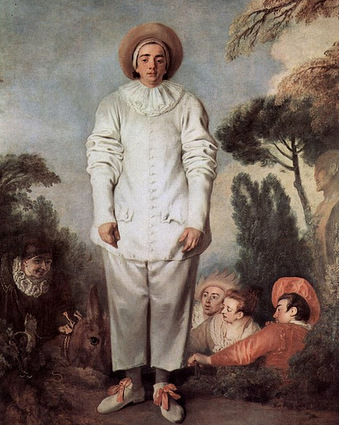|
KYSO Flash ™
Knock-Your-Socks-Off Art and Literature
|
|
|||
Mon Ami Pierrotby Kimmo Rosenthal
I had recently read “Lo mi voglio diverter” by Pierre Michon1, about how the face was the last thing to be painted, the face of the curate of Nogent, chosen because of how unremarkable and ordinary it was, the face of anyone or no one. Most likely the story is not true but, then again, does it really matter? Finally, after meandering through the Borgesian labyrinth of rooms in the Louvre, I was face to face with Pierrot, larger than life, sadly comical or was he comically sad, his fey yet saintly countenance expressing the realization that he has no idea how he came to be there or, perhaps to the contrary, he knows all too well and stands there condemned, filled with resignation. Were he to speak it would be barely audible, sounding more like incorporeal whispers than words. Corseted by disillusion and loneliness, he looks out at a world which promises only disappointment and betrayal, a world which in the end delivers so little, a world with which there is no bargaining; he is surrounded yet alone, still in thrall to the tyranny of hope, although he suspects that the consolation of possibility is no longer there as he hears the silent roar of the past and the forbidding call of a future already ordained. As I stood there I wondered whether Watteau had painted a secret version of himself, his other disillusioned, despairing self, not the one described by Michon as full of bacchanalian bravado and good spirits. Although some might view it as playful and light-hearted, the picture filled me with a sense of disquiet. The Commedia dell’arte characters in the burlesque scene behind our hero—who has nothing heroic about him—seem oblivious to Pierrot. Had they suddenly appeared from a different painting? And what are they looking at? Who is that strange totemic figure on the right-hand side, perhaps an escapee from yet a different canvas? Pierrot stands there deracinated in this strange sylvan setting that at first seems picturesque and enchanting, yet, the more one looks, becomes desolate and disturbing, signaling the absurdity and infidelity of life and the futility of our endeavors to make sense of it. The landscape behind him suggests an immensity which seems to go on forever. The sky is lowering and portentous, not becalming, suggestive of dark thoughts beginning to gather. I could feel Pierrot’s inner turmoil as if we shared a secret patrimony handed down unchanged from ancient times. Isn’t there a little Pierrot in all of us? Although he was standing, I was reminded of Rilke, “Who has not sat nervously before his own heart’s curtains?”2 Paintings allow distances and time to vanish, as our world suddenly becomes another world and, there in the Louvre, the more I thought I understood this painting the less I did, which only added to its strange appeal. Later that evening at the hotel, where my window opened onto the threshold of the night with its sweeping canopy of stars, I thought of Pierrot standing completely alone now, rooted to the same spot under the empty, white moon. I found myself humming a children’s tune I had not thought of in years: Au clair de la lune, mon ami Pierrot.3
Author’s Notes:
Publisher’s Note: Watteau’s painting is in the public domain in its country of origin and other countries and areas where the copyright term is the artist’s life plus 100 years or fewer. The original painting resides at the Louvre Museum in Paris. The reproduction above was downloaded from WikiMedia Commons. Kimmo RosenthalIssue 9, Spring 2018
has been teaching mathematics for over three decades. In the last few years he has turned his attention from mathematical research to writing fiction, poetry, and creative nonfiction. His writing has appeared in Prime Number (nominated for a Pushcart Prize), KYSO Flash, EDGE, decomP, and The Fib Review. |
|
Site contains text, proprietary computer code, |
|
| ⚡ Many thanks for taking time to report broken links to: KYSOWebmaster [at] gmail [dot] com ⚡ | |
